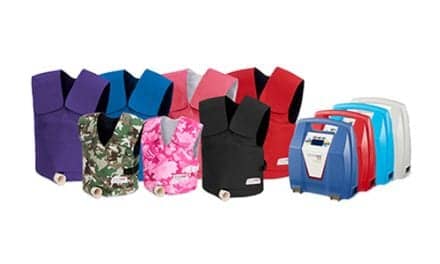This article will present notable insights from a roundtable of pulmonologists who discuss potential solutions to improve treatment strategies for non-cystic fibrosis bronchiectasis patients.
By Heather Gorby, PhD, and Martha Camacho, RN
Non-cystic fibrosis bronchiectasis (hereafter referred to as BE) is a chronic progressive respiratory disease characterized by an irreversible and abnormal dilation of the bronchial lumen.1 BE can develop in both children and adults and can be caused by immunological disorders, systemic factors or other respiratory conditions.2 Patients typically develop BE as a result of a vicious cycle of inflammation, recurrent infection, and bronchial wall damage caused by infections, genetics, inflammation, environmental factors, and/or allergies.3,4 Symptoms can significantly overlap with other respiratory conditions, such as chronic obstructive pulmonary disorder (COPD) and asthma.5,6 The pathophysiology of BE is commonly a chronic cough with purulent sputum production, dyspnea, and fatigue.2,7
Given the lack of current treatment guidelines6 regarding best practices for treating BE, in 2021 a select group of 15 US-based pulmonologists participated in a series of webinar panel discussions to discuss treating patients with BE. The practitioners shared perspectives on potential solutions that may improve treatment strategies for BE patients and promote better outcomes.8 Notable insights are shared here.
Bronchiectasis Challenges in the US
According to US government and private payor healthcare claims, BE is a disease with a growing prevalence.5,9,10 This could be explained by increased use of high-resolution CT scans better able to detect it.5 Estimates based on U.S. data from 2009 to 2013 suggest an annual incidence at 29 cases per 100,000 persons.5 The findings also suggest between 340,000 and 522,000 adults were receiving treatment for BE, with 70,000 adults newly diagnosed in 2013.5 More women than men were diagnosed with BE (67% versus 33%), and 76% of patients were 65 years of age or older.5 There also appears to be an 8% increase in new cases per year since 2001.5 Considering symptoms can be similar to other respiratory conditions, diagnosing BE can be challenging, leading to delayed diagnosis and underdiagnosis.5
Untreated, BE may lead to repeated and serious lung infections that result in increased hospitalizations and healthcare utilization.11 Impairment of mucociliary clearance may contribute to chronic inflammation and exacerbations because of the persistent presence of microorganisms in the bronchial tree.7 Chronic inflammation may further disrupt mucociliary function, resulting in tissue damage and remodeling, and a cycle of infection and inflammation that contributes to frequent exacerbations.7 Sputum retention may also cause mucus plugs that reduce airway diameter and contribute to airflow obstruction. Exacerbations of BE lead to increased daily symptoms, healthcare utilization and related costs,7,13 lower quality of life, declining lung function, and mortality.14-17
Current disease management can be complex, including treatment of concurrent etiologic conditions, promotion of airway clearance, reduction in bronchial inflammation, and suppression or prevention of chronic bronchial infection.7,12 The goal of treatment is to interrupt the vicious cycle of infections.7 Patients with BE often require frequent medical treatment over extended periods.2,9 However, there is limited research on the effectiveness of available treatments over the long term for BE.12
Bronchiectasis Diagnosis
Pulmonologists were asked to discuss some of the commonly occurring issues and barriers to diagnosis of BE. To some, high-resolution CT images provide a straightforward diagnosis. Many mentioned the potential delay for this group of patients to be referred to a specialist who can diagnose BE, at times taking years. Patients may have been treated for several years for respiratory exacerbations by primary care physicians, and this can lead to the initial BE diagnosis occurring at an advanced disease stage and in older patients. When gone undiagnosed and untreated, patients may have extensive lung damage, as well as significantly decreased lung function and poor quality of life. Some pulmonologists felt that training on how to diagnose and treat BE was lacking, even for specialists.
Considering BE is usually diagnosed via chest CT, the pulmonologists worried radiologists who focus more on detecting lung nodules may underrecognize BE. If more radiologists were able to detect and report BE, it could help speed diagnosis. Additionally, many primary care physicians do not refer patients for chest CT, which also may delay diagnosis.
Another contributing factor to the underdiagnosis of BE is the disease symptoms often overlapping with COPD and other respiratory diseases.5 Some of these symptoms include chronic cough, recurrent respiratory infection, a productive cough that gets better throughout the day, and multiple courses of antibiotics with relatively normal x-rays. The resulting underdiagnosis leads to delays in patients receiving appropriate treatment for BE.18 An analysis of US Medicare enrollees from 2006 to 2014 with prescription drug plans showed that prior to diagnosis, BE patients experienced higher inpatient and outpatient visit utilization during the year before diagnosis than that of other Medicare enrollees.9 Of these patients, 23.4% were hospitalized at least once.9 Additionally, about half (51.2%) also had a diagnosis of COPD/emphysema and 28.3% had asthma.9
Pulmonologists suggested a few steps to improve overall diagnosis of BE and perhaps diagnose it earlier. Some noted that referral for chest CT along with radiologist recognition of BE would speed diagnosis. Another suggestion encouraged pulmonologists to specifically note the suspicion of BE on the chest CT order to ensure the radiologist is looking for it and that the scan is high resolution. It may help to educate primary care physicians to emphasize the need to order a high-resolution CT to rule out BE for a patient with chronic cough. Educating primary care physicians on what to look for and when to refer to a pulmonologist may also aid earlier diagnoses.
Bronchiectasis Treatment, Airway Clearance
Chronic cough and sputum production may increase the risk of progressive decline in clinical and functional status of patients with BE.2 Airway clearance therapies (ACTs) are non-pharmacological interventions often recommended to help patients expectorate sputum from the lungs.12,19
A variety of ACTs are used in clinical practice, including positioning, gravity-assisted drainage, chest physiotherapy (CPT), breathing strategies, directed coughing, positive expiratory pressure (PEP) devices, and high frequency chest wall oscillation (HFCWO) devices.19,20 A Cochrane review of the effectiveness of ACTs with BE patients concluded their efficacy clearing mucus from the lungs, potential improvement of lung function, and i.mprovement in quality of life.20 Current guidelines for BE do suggest the use of prescription ACTs:7,12,21
The American College of Chest Physician guidelines (2018) recommends that children and adults with productive cough due to BE should be taught ACT by professionals with advanced training in ACT.12 Frequency should be determined by disease severity and amount of secretions and should be individualized to the patient.12
The European Respiratory Society guidelines (2017) recommend patients with chronic productive cough or difficulty to expectorate sputum should be taught an ACT by a trained respiratory physiotherapist.7
However, only 56% of US patients diagnosed with BE are prescribed a non-pharmacologic ACT intervention to improve bronchial hygiene, likely due to limited clinical evidence or large, randomized, controlled trials.4,12
The discussion around ACTs was centered on PEP and HFCWO therapies. The modalities selected for first-line therapy may depend on patient characteristics. For mild symptomatic patients, many pulmonologists described a combination of a PEP device with hypertonic saline and a nebulizer as first-line therapies. They noted many of these were easy to prescribe; specifically easy to order from a pharmacy and easy to use for a patient.
Effectiveness of PEP is mixed.22 Pulmonologists state it requires careful training, coaching, and follow up. Some noted PEP does not change the course of illness and patients can remain symptomatic. Some claimed PEP works for milder cases of BE and symptoms may stabilize without aggressive ACT.
Pulmonologists typically monitor for one year. If the patient has exacerbations or hospitalization and is producing excess secretions, additional treatments are considered. Some mentioned chronic infection, signs of colonization, or disease worsening on chest CT indicate a given treatment is not working and it is time to move towards a more aggressive form of ACT.
HFCWO is administered with a vest-like garment capable of generating airflow oscillations that produce cough-like forces that may shear secretions from the walls of the airways and decrease secretion viscosity.23 HFCWO has become a beneficial part of therapy for patients with cystic fibrosis, with many studies reporting benefits in combination with other therapies.19 It was noted that physicians in the U.S. often wait to prescribe HFCWO for BE patients who have more severe disease, frequent exacerbations, symptoms, and secretions. Some noted older patients were more likely to be prescribed HFCWO.
Some pulmonologists prescribe HFCWO earlier in the course of the disease instead of waiting for declining lung function and increased exacerbations and mentioned that it is effective and relatively harmless. They noted earlier treatment with HFCWO and keeping airways clear is one of the only ways to stabilize BE.
Should HFCWO Be Leveraged More?
Although there is limited data on the use of HFCWO to treat BE, there are studies comparing its clinical outcomes with other ACTs, alone and in combination with other therapies. One study compared traditional PEP/CPT techniques, HFCWO, and medication only (control group). This study found that HFCWO showed significant improvement in quality of life measures, markers of inflammation and some lung function parameters compared to the control group and PEP/CPT.24
Another group of patients with BE, symptoms and more than two exacerbations in the previous year, were assigned to an observational study adding HFCWO to a standard treatment regimen for BE (nebulized bronchodilator, nebulized mucolytic, and assessment for macrolide therapy).25 Patients were observed every two to three months for a period of one year. The treatment algorithm, including use of HFCWO, significantly decreased severe exacerbations as well as the number of courses of antibiotics and lung function remained stable.25 Additionally, a case review reported reductions in BE-related healthcare utilization, like antibiotic and steroid use after one year of HFCWO therapy.26 Newly analyzed claims data suggests HFCWO may lead to decreases in hospitalization, office visits, and antibiotic use, sustained out to three years.27-30
Pulmonologists thought HFCWO device usage reduces the frequency of exacerbations and patients tend to do very well with the therapy. However, some pulmonologists mentioned HFCWO devices may only be tried when a patient has been hospitalized. If HFCWO was useful at the hospital, it may then be prescribed for home use. They noted physicians, particularly non-pulmonologists, may not be aware of the benefits of using HFCWO and broader awareness of treatment options for BE is needed. Some mentioned that when a patient’s lungs are infected with organisms such as non-tuberculosis mycobacterium (NTM), treatment tends to be more aggressive.
Most pulmonologists recommended individualized treatment versus applying any standard algorithm or guideline. Evidence of BE condition worsening supported by imaging and spirometry data are indications for HFCWO. Pulmonologists mentioned multiple exacerbations and/or hospitalizations with difficulty bringing up secretions or hypersecretion indicate the need for additional treatments. Some pulmonologists noted patients with structural lung damage may start on more aggressive treatment.
HFCWO Therapy Compliance and Keys to Success
Patient selection along with expectation setting is key-the motivated patient is a suitable candidate for treatment with HFCWO. Therapy adherence issues were mentioned as an example of a barrier to patient compliance to HFCWO therapy, explained to be resulting from a variety of factors including understanding of therapy benefits, commitment to doing the therapy, and some chest pain. Patients with back or chest pain, compression fractures, etc, may not do well with HFCWO and may prefer another airway clearance device like oscillation and lung expansion (OLE) therapy. Patients with pacemakers or other subcutaneous devices may not be able to use HFCWO and report discomfort.
Physicians also need to be committed to their patients and working through any issues that may arise to effectively treat BE. There was a suggestion to investigate why a patient may not be using HFCWO as prescribed and tease out the source of the issue to see if it can be worked through. There may be instances where frequency and duration of HFCWO use can be reduced when a patient feels better. Pulmonologists reiterated tracking patients with BE was important and adjusting their treatments or providing additional patient education was vital to success. Patients who find benefit with HFCWO are likely to keep using it.
HFCWO Device Cost & Insurance Reimbursement
Perceptions of device reimbursement and initial cost can be a barrier for both patients and physicians. A few pulmonologists mentioned a minority of their patients were resistant to HFCWO because of costs, but for most, it is not a concern. Some noted cost was a bigger concern a few years ago but it has lessened since due to increased insurance reimbursement. Among the group, there was varied experience with insurance coverage for HFCWO. Some pulmonologists will monitor exacerbations for at least a year before considering adding HFCWO. Some noted that a patient had to experience three or more exacerbations
in a year and have documented failure with standard treatments for mobilizing retained secretions prior to receiving Medicare reimbursement for HFCWO.
Preliminary data suggests healthcare costs are reduced after the first year of HFCWO use, sustained to three years, driven by decreases in hospitalization, office visits, and antibiotic use.27-30
Moving the Field Forward
Additional education for physicians on BE could help further understanding of the disease and enable more informed decisions regarding diagnosis, treatment options and optimal use. Additionally, it is important to follow up with patients more frequently regarding their therapy progress. This will help identify the need to improve adherence of current therapies and better understand when to transition to a more aggressive therapy.
Pulmonologists mentioned some patients could benefit from additional training and education in the outpatient setting. Non-branded materials on BE, such as lung diagrams, educational videos, etc. could be useful tools.
Additional clinical research and studies to help understand BE and treat it more effectively are also needed. Specifically, studying the effectiveness of HFCWO could help drive earlier adoption of this therapy. Much of the current evidence on ACTs and HFCWO is based on short-term studies.6,20 More research carried out for a longer duration could help to establish efficacy.6,20 Research on the optimal timing for HFCWO was also requested by pulmonologists. More evidence on outcomes related to exacerbation rates, hospitalization, and antibiotic prescription in patients treated with HFCWO could be helpful to establish its place in the treatment algorithm for BE.20
RT
Heather Gorby, PhD, is an award-winning medical writer has helped author dozens of journal articles and white papers in a variety of therapeutic areas. Martha Camacho Urribarri, RNC, is a Medical Affairs Manager for Respiratory Health at Baxter, where she specializes on the research of therapies for patients with bronchiectasis. This manuscript was submitted by Baxter Healthcare. For more info, contact [email protected].
References
- Barker AF. Bronchiectasis. N Engl J Med. 2002;346(18):1383-1393.
- McShane PJ, Naureckas ET, Tino G, Strek ME. Non-cystic Fibrosis Bronchiectasis. Am J Respir Crit Care Med. 2013;188(6):647-656.
- Cole PJ. Inflammation: A Two-Edged Sword – The Model of Bronchiectasis. Eur J Respir Dis. 1986; 16 (Suppl 147): 6-15.
- Aksamit TR, O’Donnell AE, Barker A, et al. Adult Patients with Bronchiectasis: A First Look at the US Bronchiectasis Research Registry. Chest. 2017;151(5):982-992.
- Weycker D, Hansen GL, Seifer FD. Prevalence and Incidence of Noncystic Fibrosis Bronchiectasis Among US Adults in 2013. Chron Respir Dis. 2017;14(4):377-384.
- Henkle E, Aksamit TR, Daley CL, et al. US Patient-Centered Research Priorities and Roadmap for Bronchiectasis. Chest. 2018;154(5):1016-1023.
- Polverino E, Goeminne PC, McDonnell MJ, et al. European Respiratory Society Guidelines for the Management of Adult Bronchiectasis. Eur Respir J . 2017;50(3):1700629.
- Virtual Webinar Panel Discussions in 2021 with 15 Pulmonologists Practicing in the United States. Summaries on file at at Baxter.
- Henkle E, Chan B, Curtis JR, et al. Characteristics and Health-care Utilization History of Patients with Bronchiectasis in US Medicare Enrollees with Prescription Drug Plans, 2006 to 2014. Chest. 2018;154(6):1311-1320.
- Quint JK, Millett ER, Joshi M, et al. Changes in the Incidence, Prevalence and Mortality of Bronchiectasis in the UK from 2004 to 2013: A Population-based Cohort Study. Eur Respir J. 2016;47(1):186-193.
- Weycker D, Edelsberg J, Oster G, Tino G. Prevalence and Economic Burden of Bronchiectasis. Clinical Pulmonary Medicine. 2005;12(4):205-209.
- Hill AT, Barker AF, Bolser DC, et al. Treating Cough Due to Non-CF and CF Bronchiectasis with Nonpharmacological Airway Clearance: CHEST Expert Panel Report. Chest. 2018;153(4):986-993.
- Seifer FD, Hansen G, Weycker D. Health-care Utilization and Expenditures Among Patients with Comorbid Bronchiectasis and Chronic Obstructive Pulmonary Disease in US Clinical Practice. Chron Respir Dis. 2019;16:1479973119839961.
- Aliberti S, Lonni S, Dore S, et al. Clinical Phenotypes in Adult Patients with Bronchiectasis. Eur Respir J. 2016;47(4):1113-1122.
- Kapur N, Masters IB, Chang AB. Longitudinal Growth and Lung Function in Pediatric Non-cystic Fibrosis Bronchiectasis: What Influences Lung Function Stability? Chest. 2010;138(1):158-164.
- Chalmers JD, Goeminne P, Aliberti S, et al. The Bronchiectasis Severity Index. An International Derivation and Validation Study. Am J Respir Crit Care Med. 2014;189(5):576-585.
- Goeminne PC, Scheers H, Decraene A, et al. Risk Factors for Morbidity and Death in Non-cystic Fibrosis Bronchiectasis: A Retrospective Cross-sectional Analysis of CT Diagnosed Bronchiectatic Patients. Respir Res. 2012;13(1):21.
- McDonnell MJ, Ward C, Lordan JL, Rutherford RM. Non-cystic Fibrosis Bronchiectasis. Q J Med. 2013;106(8):709-715.
- McIlwaine M, Button B, Nevitt SJ. Positive Expiratory Pressure Physiotherapy for Airway Clearance in People with Cystic Fibrosis. Cochrane Database Syst Rev. 2019;2019(11).
- Lee AL, Burge AT, Holland AE. Airway Clearance Techniques for Bronchiectasis. Cochrane Database Syst Rev. 2015;2015(11):Cd008351.
- Hill A, Sullivan A, Chalmers J, et al. British Thoracic Society Guideline for Bronchiectasis in Adults. Thorax. 2019;74(Suppl 1):1-69.
- Lee AL, Burge AT, Holland AE. Positive Expiratory Pressure Therapy Versus Other Airway Clearance Techniques for Bronchiectasis. Cochrane Database Syst Rev. 2017;9(9):Cd011699.
- Dosman CF, Jones RL. High-frequency Chest Compression: A Summary of the Literature. Can Respir J. 2005;12(1):37-41.
- Nicolini A, Cardini F, Landucci N, et al. Effectiveness of Treatment with High-Frequency Chest Wall Oscillation in Patients with Bronchiectasis. BMC Pulm Med. 2013;13:21.
- Powner J, Nesmith A, Kirkpatrick DP, et al. Employment of an Algorithm of Care Including Chest Physiotherapy Results in Reduced Hospitalizations and Stability of Lung Function in Bronchiectasis. BMC Pulm Med. 2019;19(1):82.
- Sievert CE, Beaner CA, Sievert CP. Using High Frequency Chest Wall Oscillation in a Bronchiectasis Patient Population: An Outcomes-Based Case Review. Respiratory Therapy. 2016;11(Fall):34-38.
- Basavaraj A, Shah D, DeKoven M, et al. A Pre-Post Analysis Assessing the 3-Year Long-Term Impact of High Frequency Chest Wall Oscillation Therapy on Clinical Outcomes, Healthcare Cost and Utilization in Adult Patients with Non-Cystic Fibrosis Bronchiectasis in the U.S. [Abstract]. Am J Respir Crit Care Med. 2021;203:A3944.
- Basavaraj A, DeKoven M, Shah D, et al. Impact of High Frequency Chest Wall Oscillation on Clinical Outcomes and Healthcare Resource Utilization in Adult Patients with Non-Cystic Fibrosis Bronchiectasis in the United States: A Pre-Post Cohort Analysis [Abstract]. American Journal of Respiratory and Critical Care Medicine 2020;201:A7758.
- Basavaraj A, Shah D, Dekoven M, et al. Clinical Outcomes and Healthcare Resource Utilization in Adult High-Risk Patients with Noncystic Fibrosis Bronchiectasis Using High Frequency Chest Wall Oscillation and Positive Expiratory Pressure Therapy. Chest. 2020;158(4):A1695-A1696.
- Basavaraj A, Shah D, Dekoven M, et al. Two Year Clinical Outcomes and Healthcare Resource Utilization in Adult Patients with High Risk Noncystic Fibrosis Bronchiectasis on High Frequency Chest Wall Oscillation. Chest. 2020;158(4):A1693-A1694.










